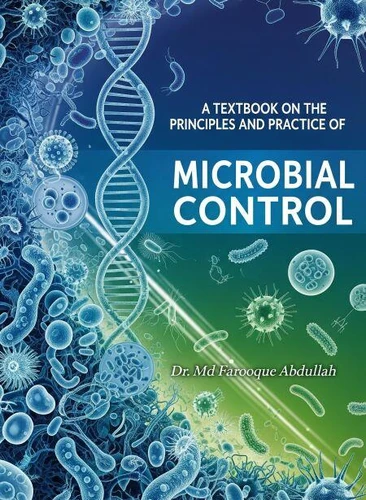Nouveauté
A Textbook on the Principles and Practice of Microbial Control
Par :Formats :
Actuellement indisponible
Cet article est actuellement indisponible, il ne peut pas être commandé sur notre site pour le moment. Nous vous invitons à vous inscrire à l'alerte disponibilité, vous recevrez un e-mail dès que cet ouvrage sera à nouveau disponible.
Disponible dans votre compte client Decitre ou Furet du Nord dès validation de votre commande. Le format ePub est :
- Compatible avec une lecture sur My Vivlio (smartphone, tablette, ordinateur)
- Compatible avec une lecture sur liseuses Vivlio
- Pour les liseuses autres que Vivlio, vous devez utiliser le logiciel Adobe Digital Edition. Non compatible avec la lecture sur les liseuses Kindle, Remarkable et Sony
 , qui est-ce ?
, qui est-ce ?Notre partenaire de plateforme de lecture numérique où vous retrouverez l'ensemble de vos ebooks gratuitement
Pour en savoir plus sur nos ebooks, consultez notre aide en ligne ici
- FormatePub
- ISBN8231221745
- EAN9798231221745
- Date de parution01/08/2025
- Protection num.pas de protection
- Infos supplémentairesepub
- ÉditeurWalzone Press
Résumé
A Textbook on the Principles and Practice of Microbial Control provides a comprehensive and foundational understanding of the essential science of microbial inactivation. This resource is designed for students, educators, and professionals in microbiology, healthcare, food science, and public health who require a mastery of this critical field. The book begins by establishing the fundamental principles of microbial control, defining the hierarchy of terms from sanitation to sterilization, and exploring the key factors that influence an agent's effectiveness.
It then systematically delves into the practice of microbial control by examining the full spectrum of available methods. Readers will explore the mechanisms and applications of physical methods, including moist and dry heat sterilization, pasteurization, filtration, and radiation. The textbook then transitions to a detailed analysis of chemical methods, covering the properties and uses of disinfectants, antiseptics, and chemical sterilants, from alcohols and halogens to advanced gaseous agents.
A crucial section is dedicated to the scientific evaluation of antimicrobial efficacy. You will learn the history and limitations of early methods and master modern, standardized tests such as the Disk-Diffusion method, the E-test, and the quantitative assays for Minimum Inhibitory and Bactericidal Concentrations (MIC and MBC). This textbook is more than a simple guide; it is a meticulously structured curriculum that bridges the gap between theory and real-world application, offering the knowledge and principles necessary to ensure safety, prevent disease, and maintain sterile environments in a wide range of professional settings.
It then systematically delves into the practice of microbial control by examining the full spectrum of available methods. Readers will explore the mechanisms and applications of physical methods, including moist and dry heat sterilization, pasteurization, filtration, and radiation. The textbook then transitions to a detailed analysis of chemical methods, covering the properties and uses of disinfectants, antiseptics, and chemical sterilants, from alcohols and halogens to advanced gaseous agents.
A crucial section is dedicated to the scientific evaluation of antimicrobial efficacy. You will learn the history and limitations of early methods and master modern, standardized tests such as the Disk-Diffusion method, the E-test, and the quantitative assays for Minimum Inhibitory and Bactericidal Concentrations (MIC and MBC). This textbook is more than a simple guide; it is a meticulously structured curriculum that bridges the gap between theory and real-world application, offering the knowledge and principles necessary to ensure safety, prevent disease, and maintain sterile environments in a wide range of professional settings.
A Textbook on the Principles and Practice of Microbial Control provides a comprehensive and foundational understanding of the essential science of microbial inactivation. This resource is designed for students, educators, and professionals in microbiology, healthcare, food science, and public health who require a mastery of this critical field. The book begins by establishing the fundamental principles of microbial control, defining the hierarchy of terms from sanitation to sterilization, and exploring the key factors that influence an agent's effectiveness.
It then systematically delves into the practice of microbial control by examining the full spectrum of available methods. Readers will explore the mechanisms and applications of physical methods, including moist and dry heat sterilization, pasteurization, filtration, and radiation. The textbook then transitions to a detailed analysis of chemical methods, covering the properties and uses of disinfectants, antiseptics, and chemical sterilants, from alcohols and halogens to advanced gaseous agents.
A crucial section is dedicated to the scientific evaluation of antimicrobial efficacy. You will learn the history and limitations of early methods and master modern, standardized tests such as the Disk-Diffusion method, the E-test, and the quantitative assays for Minimum Inhibitory and Bactericidal Concentrations (MIC and MBC). This textbook is more than a simple guide; it is a meticulously structured curriculum that bridges the gap between theory and real-world application, offering the knowledge and principles necessary to ensure safety, prevent disease, and maintain sterile environments in a wide range of professional settings.
It then systematically delves into the practice of microbial control by examining the full spectrum of available methods. Readers will explore the mechanisms and applications of physical methods, including moist and dry heat sterilization, pasteurization, filtration, and radiation. The textbook then transitions to a detailed analysis of chemical methods, covering the properties and uses of disinfectants, antiseptics, and chemical sterilants, from alcohols and halogens to advanced gaseous agents.
A crucial section is dedicated to the scientific evaluation of antimicrobial efficacy. You will learn the history and limitations of early methods and master modern, standardized tests such as the Disk-Diffusion method, the E-test, and the quantitative assays for Minimum Inhibitory and Bactericidal Concentrations (MIC and MBC). This textbook is more than a simple guide; it is a meticulously structured curriculum that bridges the gap between theory and real-world application, offering the knowledge and principles necessary to ensure safety, prevent disease, and maintain sterile environments in a wide range of professional settings.



